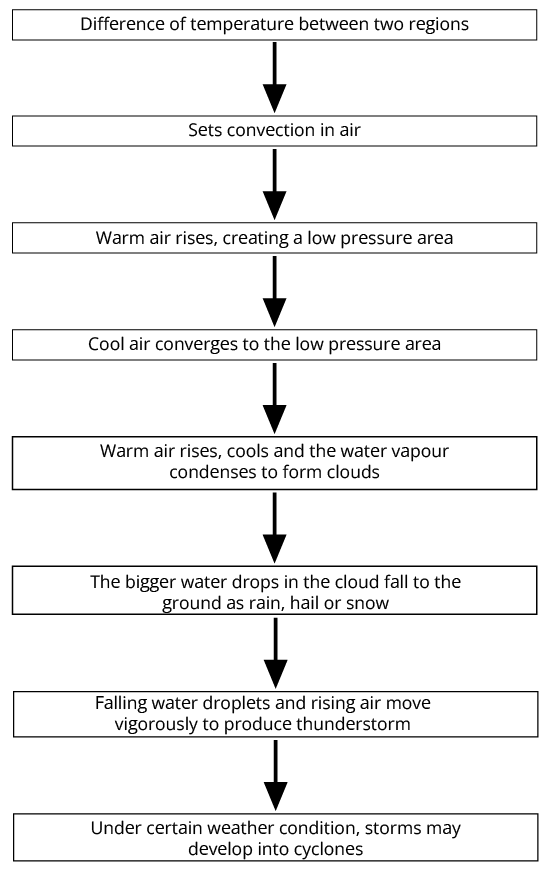

CBSE Class 7 Science Notes Chapter 8: In class 7, chapter 8 is crucial. On the final exam, there are numerous questions about this chapter that students must respond to. In addition, students are taught important skills in this chapter that have a wide range of real-world applications. For this reason, we have class 7 notes on winds, storms, and cyclones ready.
We offer these review notes for students to download. A PDF file containing the notes is accessible. The top academic authors in India are in charge of creating the revision notes. Students who use these notes will be able to achieve the best grades possible. Just download now to get the revision notes.CBSE Class 7 Science Notes Chapter 8 Overview
Let's begin the discussion of air pressure in the class 7 science chapter 8 notes. Experts claim that the air surrounds us constantly and applies pressure. Furthermore, wind is the air's inherent mobility. There is a stream flowing in either direction that causes this motion. The key questions address a range of topics related to minerals and energy resources, such as their description, classification, distribution, mining, difficulties, and importance in contemporary society. Students can efficiently prepare for their exams, strengthen their knowledge, and develop their problem-solving abilities by attempting these questions.CBSE Class 7 Science Notes Chapter 8 PDF
Here we have provided CBSE Class 7 Science Notes Chapter 8 for the ease of students so that they can just download the pdf and use it easily without the internet. These CBSE Class 7 Science Notes Chapter 8 will help students understand the chapter better.CBSE Class 7 Science Notes Chapter 8 PDF
CBSE Class 7 Science Notes Chapter 8
Air is the name for the invisible gaseous substance that envelops the planet. Air is made up of trace amounts of various gases by volume, along with nitrogen (78.09 percent), oxygen (20.95 percent), argon (0.93 percent), and carbon dioxide (0.04 percent). There is also water vapour in the air, with an average concentration of 0.4% in the atmosphere and about 1% at sea level.-
Air has the Following Properties:
-
It exerts pressure on us.
-
When air is heated, it expands and contracts.
-
Warm air rises, while cooler air sinks towards the earth's surface.
-
As warm air rises, air pressure drops at that location, allowing cooler air to move in.
The term "wind" refers to the movement of air. Air travels from a high-pressure region to a low-pressure zone.
Air Pressure
High air pressure areas give way to low air pressure areas when air moves through them. The pressure differential increases with air velocity. The force that the air always applies to all bodies in all directions is known as air pressure. High-speed air movements generate an area of low pressure. The air within a balloon presses against itself from all sides, forcing it to expand. Air opposes the motion of an object in motion. The term for this is air resistance. This is the reason you have to exert yourself and peddle hard when riding a bicycle.Air expands on heating
Compared to warm or hot air, cool air is heavier. Cool air drops and warm air rises like smoke. A pressure drop results from warm air rising, while cooler air from higher pressure rushes in to fill the void.Wind Types Include
Wind Currents: When the earth's surface heats up unevenly, wind currents are produced. Wind currents are a result of the Earth's uneven heating. This indicates that there is different warmth at the poles and the equator. Colder air from the 0–30 degree latitude region on each side of the equator moves in to replace the warm air as it rises. This is how wind currents are generated. Thunderstorms: A thunderstorm characterised by rain, lightning, and thunder. Rising air and falling water droplets moving quickly together produce sound and lightning. We call something like this a thunderstorm.Thunderstorm to Cyclone Conversion
When water in the atmosphere turns from vapour to rain during a thunderstorm, heat is released. As a result, the surrounding air gets warmer and the pressure drops. Air rushes in towards the storm's centre as a result. Large low-pressure systems are brought on by this cycle, and the powerful, fast winds that surround it swirl. Here is where a cyclone forms. Winds that carry water vapour provide rain. A difference in air pressure combined with strong winds can create cyclones. Utilising cutting-edge technologies like radars and satellites has simplified the process of keeping an eye on cyclones. Self-help is best of all. Therefore, it is best to make plans in advance and be ready to repel any cyclone that may be approaching. In our country, tornadoes are not common. Dark clouds with a funnel-like shape that descend from the sky are called tornadoes. Most tornadoes are not very strong. A tornado's top speed is 300 miles per hour. Tornadoes can form inside cyclones. The flowchart below will assist you in comprehending the phenomena that cause clouds to form, rain to fall, and storms and cyclones to form. Thanks to satellites and radars, a cyclone warning is issued 24 hours in advance of any anticipated cyclone, while a cyclone notice or watch is issued 48 hours in advance. Every hour or thirty minutes, the notice is broadcast when a cyclone is headed towards the coast. Numerous domestic and global institutions collaborate to keep an eye on cyclone-related calamities.
Thanks to satellites and radars, a cyclone warning is issued 24 hours in advance of any anticipated cyclone, while a cyclone notice or watch is issued 48 hours in advance. Every hour or thirty minutes, the notice is broadcast when a cyclone is headed towards the coast. Numerous domestic and global institutions collaborate to keep an eye on cyclone-related calamities.
Types of Cyclones
Different names for cyclones are used in different places of the world. In the American continent, they are referred to as hurricanes, and in Japan, as typhoons.Tornado
A cyclone contains a tornado. It resembles a revolving funnel that draws everything at the top and expels everything at the bottom, including dust and debris. It can travel at up to 300 km/hr and has a diameter of one to five metres.Coriolis Effect
The force due to the Earth’s rotation that tries to deflect winds towards left or right is known as the Coriolis effect.The destruction caused by Cyclones
Even when a storm is hundreds of miles distant, strong winds force water closer to the coast. The wind creates waves of water so strong that no one can stand against them. The water's surface is raised in the centre by the eye's low pressure. There could be a 3–12 metre rise in the rising water. When seawater seeps into low-lying coastal areas, it severely destroys property and causes fatalities. It also lessens the soil's fertility. Prolonged, intense rain might make the flood scenario even worse.Action taken by the people
We must heed the alerts that the meteorological agency issues via radio, TV, and newspapers. We ought to organise for the necessary relocation of domestic animals, automobiles, and other necessities to safer locations. Stay off of standing water-covered roadways since floods may have damaged them; also, have the phone numbers of all emergency services, including the fire department, police, and ambulance, on hand.Safety Measures and Role of Advanced Technology
Steps to follow if a storm is followed by lightning
- Do not seek cover under solitary trees.
- If you're in a forest, look for cover beneath a tiny tree.
- Avoid lying down on the ground.
- Never attempt to hide under an umbrella.
- Don't sit next to open garages or metal sheds.
- If in the water, quickly get out and inside a structure.
- A bus or automobile is a secure location to hide.
Measures of Safety from Tornados
- Cyclone forecast and warning system.
- Rapid warning systems to Governments fishermen, and people in prone zones.
- Construction of cyclone shelters and rapid evacuation schemes.
- Avoiding fallen power lines.
- Cooperation with others and rescue teams.
Benefits of CBSE Class 7 Science Notes Chapter 8
Our class 7 science notes have a lot of advantages. Among those advantages are:- Rewrite scientific chapters quickly and painlessly.
- Get top grades.
- Get the revised PDF file here at no cost.
- Discover responses penned by the most accomplished academic professionals.
CBSE Class 7 Science Notes Chapter 8 FAQs
What happened in chapter 8 of class 7 science?
What are cyclone class 7 notes?
What are wind currents Class 7 notes?











